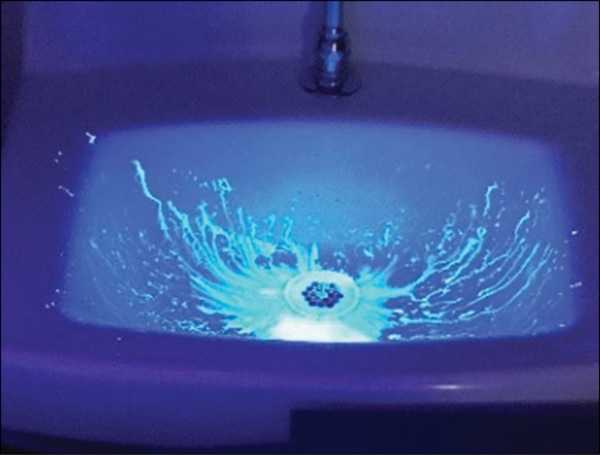When it comes to preventing nosocomial infections, washing your hands is rule No. 1. But new evidence shows that where you wash your hands also matters.
Certain design features of sinks, including a relatively shallow bowl and a supplementary feature added to the end of a faucet to reduce water flow, can contribute to the spread of microbes, according to a new study from researchers based at the University of Michigan, in Ann Arbor.
The researchers found that sinks with shallow bowls can splash contaminated water onto providers’ clothing and any patient care items within a radius of several feet away; meanwhile, faucet ends, or spouts, with aerators contained potentially harmful microbes, the Michigan researchers found.
Although shallow sinks and aerators are common in many health care settings, hospitals must ensure their hand-washing stations are not contributing to the spread of infections, said Harry Zhen, MPH, an infection prevention analyst at Michigan Medicine, who presented the findings at the 2019 annual meeting of the Association for Professionals in Infection Control and Epidemiology. “You need to find that balance between having the appropriate sink design while making it ergonomically useful for people to wash their hands.”
Mr. Zhen and his colleagues analyzed 20 faucets and sinks in four ICUs after reading previous studies that showed sinks can be an unknowing source of outbreaks. For more than a year starting in December 2004, 36 patients at Toronto General Hospital were infected with a multidrug-resistant strain of Pseudomonas aeruginosa; 17 died within three months. An investigation tracked the source of the outbreak to hand hygiene sink drains (Infect Control Hosp Epidemiol 2009;30[1]:25-33).
“We wanted to prevent something like that from happening at our institution,” Mr. Zhen told Gastroenterology & Endoscopy News. “We wanted to see how clean our faucets and sinks are and whether our designs enable problematic splashing, so that we could make sure we were taking appropriate preventative measures.”
During the study, the Michigan team found that spouts had higher readings of adenosine triphosphate than sink bowls, indicating a higher concentration of organic matter. None of the faucets was supposed to have aerators, because they can serve as a breeding ground for microbes, but some had been added back on after previous removal; not surprisingly, sinks with aerators had more contamination, and the researchers spotted visible biofilms on multiple spouts and aerators.
Cultures produced Pseudomonas aeruginosa, mold and other organisms. Although the researchers expected to find some contamination, “we weren’t expecting our readings to be as high as they were [or]that our faucets were that contaminated,” Mr. Zhen said.
To study splashing, the researchers placed a fluorescent marker near the drain, where microorganisms may linger, contaminating the sink bowl; when researchers washed their hands and turned the faucet on and off, the splash dispersed the fluorescent marker, showing how far water can carry drain microbes. The researchers found that deep sink bowls had less splashing outside the bowl. However, some shallower “sink designs enabled splashing up to 4 feet from the sink,” Mr. Zhen said.
Although the infection prevention community has become increasingly aware of the potential danger of some sink designs, that realization hasn’t hit the medical community at large, said Susy Hota, MD, MSc, a clinician investigator at Toronto General Hospital Research Institute (TGHRI). “It is my impression that most clinicians and hospital administrators outside of the infection control world are largely unaware of the potential hazards of sinks.”
Dr. Hota knows the risks; she was a resident in infectious diseases at Toronto General Hospital during the outbreak. “I was doing a rotation in the microbiology laboratory at the time and became involved out of interest, as we were receiving cultures of highly resistant Pseudomonas aeruginosa from the outbreak,” she recalled. “I have remained interested in the importance of sink design in infection transmission ever since.”
Other risky features include electronic eye faucets, small sink dimensions, porous sink materials, the presence of sink plugs, problems with sink drainage, and faucets that discharge water directly into the drain and splash its contents, she added.
Unfortunately, many hospitals were built several decades ago, before planners were aware of the impact of design on the spread of infections. And simply replacing sinks—which can cost thousands of dollars—may not be enough, Dr. Hota noted, as distal piping can be colonized with microbes, which have been shown to ascend sink tailpipes at a rate of approximately 1 inch per day (Appl Environ Microbiol 2017;31[83]: e03327-16.
But there are ways to reduce the risk of infection from sinks, she added—cleaning and disinfecting contaminated sinks using mechanical force, chemicals and heat can address the problem at least temporarily. Beyond this, simple modifications can be made to sinks and patient room design to reduce the risk for transmission to patients and health care providers, she suggested, such as erecting splashguards, repositioning faucets to avoid discharging into drains, removing adjacent millwork and surfaces for supply storage and preparation, and moving the patient’s bed head away from the sink. Indeed, based on the results of the latest study, Mr. Zhen and his team are initiating a faucet replacement program to install spouts that cannot accept an aerator, and ensuring that splash guards are appropriately installed on sinks that dispersed more water.
{RELATED-HORIZONTAL}“Sinks will never be sterile, so our focus should be on ensuring engineering controls and human factors modifications to enable safe use of sinks,” Dr. Hota said. “Health care facilities should take stock of their existing sinks and mitigate risk accordingly.”
—Alison McCook
Mr. Zhen and Dr. Hota reported no relevant financial conflicts of interest.



